 Does content marketing sometimes feel like a challenge?
Does content marketing sometimes feel like a challenge?
Like you’ve got to produce a never-ending stream of content?
A blog. A newsletter. LinkedIn. YouTube. Insta.
Wherever you’re marketing your business, it may never seem enough.
Never enough content.
Never enough time.
Soooo … how do we stay sane?
I’d like to offer a different perspective on marketing and writing for your biz.
A more sustainable way that gives you joy and energy.
What’s more …
This perspective will invigorate your readers and clients, too, and help you grow your business.
Shall I explain?
1. How to do your best writing
The standard content marketing advice is to write for your reader: Help your reader achieve their aims, solve their problems, and answer their questions.
But that’s not enough …
Because if you only share tips, then your writing can be easily exchanged for anyone else’s writing. You’re not building a strong relationship with your reader.
So, what to do?
Don’t just write for your reader; write for yourself, too.
Don’t just write about what you know; write about what you want to learn, too.
Follow your curiosity and write about what you’re discovering, what matters to you, what makes you excited to write. Your enthusiasm breathes life into your words, and your readers will notice. A spark transfers from you as writer to your readers.
YOU and your enthusiasm are the secret ingredient in your best writing.
And you know what?
When you do your best writing (from the heart!) you connect more strongly with your audience.
And when you connect more strongly, you can let go of that punishing schedule of more more more.
Focus on quality, on real connections, on real conversations, and then find a publishing schedule that works for you, that keeps you connected to the joy of creating.
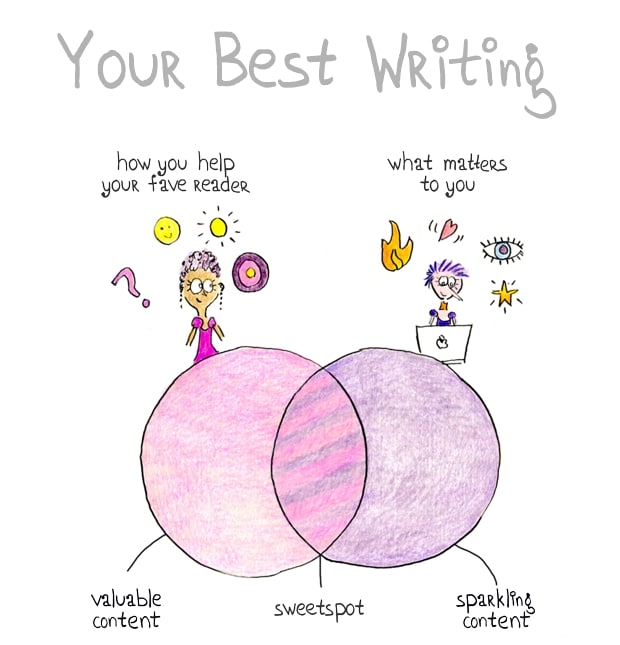
2. How to make content marketing work for your business
Big corporations can afford to be boring.
Because they have tons of money to buy brand awareness.
But for small businesses and freelancers, life is different. We don’t have heaps of money, so we have to fascinate our audience with fewer resources.
But we have these secret ingredients I’ve told you about …
Our joy. Our personality. Our enthusiasm.
So, let that joy feed your wish to help your readers.
People notice when your content is in line with your beliefs and values, and when your content becomes unmistakably you. You connect with the people who are right for you, and that fuels your motivation to keep creating content and building your business.
Good writing connects, and to connect you need emotion, and to write with emotion, you need to care about what you’re writing. You can’t fake it.
So, whenever things go awry and you feel overwhelmed by content marketing, reconnect with that inner joy—the inherent joy of creating.
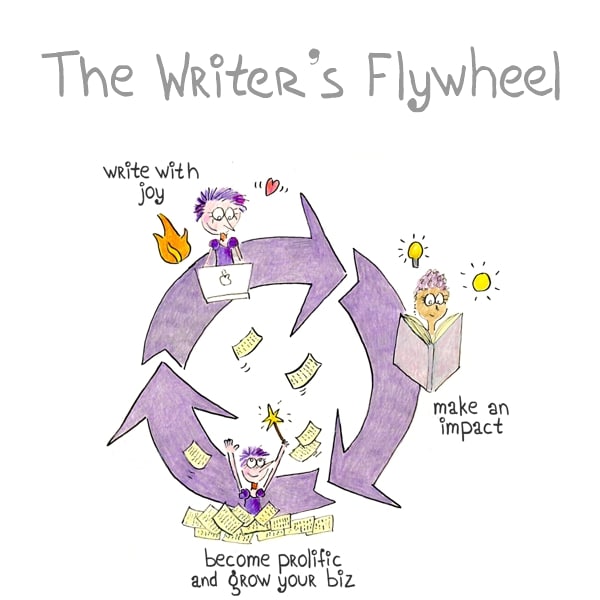
How to stay creative
Creativity can seem fickle.
Just when you need to write your next blog post or newsletter or social media post, you can’t seem to find an idea.
Sound familiar?
Here’s how to keep that inner fire burning and stay inspired all year round …
3. Know what input you require
As Austin Kleon suggests, a problem of output is often a problem of input.
So, if you’re out of inspiration, first consider what content you’re consuming.
When we read the same as everyone else, we’ll produce similar content, and we’re at risk of going stale.
So, follow your curiosity and rewild your attention. Read something off the beaten track.
Secondly, review what else is required to keep your creative soul happy. I need rest, plenty of tea, walks, and quietude.
What feeds your creative soul?
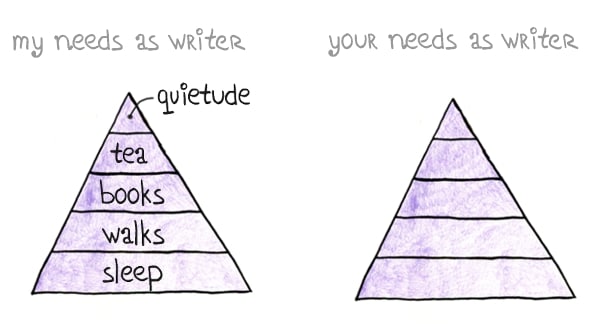
4. Get out of your comfort zone
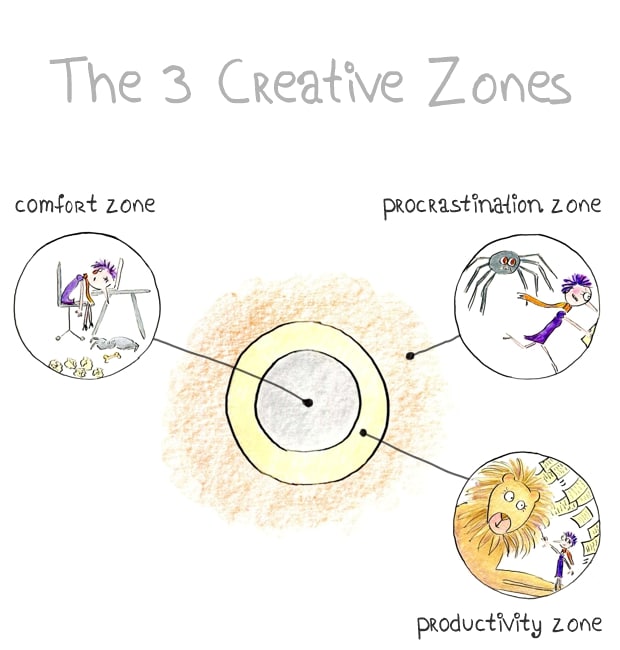
There are 3 creative zones:
- The inner zone is your comfort zone, where you create on auto-pilot and risk going stale.
- The outer zone is the procrastination jungle, where you spend your energy fighting your fears and where you risk procrastination.
- The in-between zone is your most productive zone, where you’re outside your comfort zone but not too far.
It’s just outside your comfort zone where you find your creative challenges and do your best work.
So, if you feel like you’re going stale, give yourself a new challenge. Write about something different. Take on a bigger client. Or try a new creative writing technique.
Keep challenging yourself.
Have fun.
5. Focus on joy
I hear you.
I used to have a hate/love relationship with writing. Yet, over time, I learned to lean into the joy of writing. It’s about both detachment and focus:
- Detachment: Learn to let go of expectations and stop worrying about the number of comments and likes and impressions a post may get.
- Focus: Relentlessly focus on the task in front of you whether that’s writing a crappy first draft, revising, editing, or proofreading. Pay attention. Do your best.
Remember:
No matter how hard or wonky the writing process sometimes is, there’s inherent joy in creating something that didn’t exist before.
Embrace that joy.
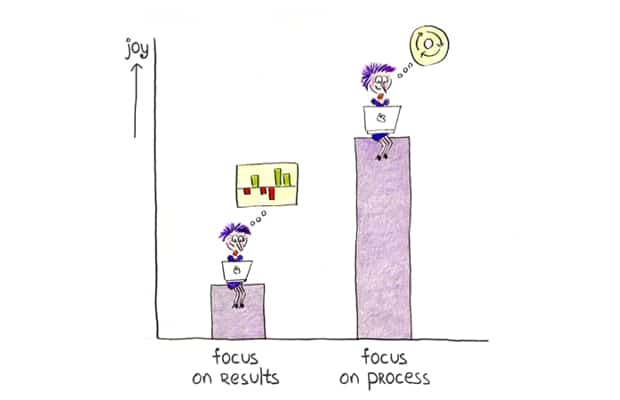
Become a better writer
You know what’s so fun when your writing skills improve?
First, your writing makes more impact because you know how to captivate, educate, inspire, and persuade your readers.
Secondly, writing becomes more joyful as you make your words sing.
So, here are 3 tips on improving your writing skills …
6. Find sustainable growth
Is that sneaky voice spoiling the fun of writing?
I’ve been there, too.
Struggling to write is human.
But please don’t accept what your inner critic tells you.
If your inner critic tells you that you’re a bad writer, be sure to correct them.
No one is a bad writer, and all of us are learning to write better.
To find growth as a writer, embrace two contradictory beliefs:
- Remind yourself (and your inner critic) you’re already good enough.
- Acknowledge you can improve.
On the intersection of those two beliefs, you’ll find sustainable growth.
And improving your skills becomes more fun.
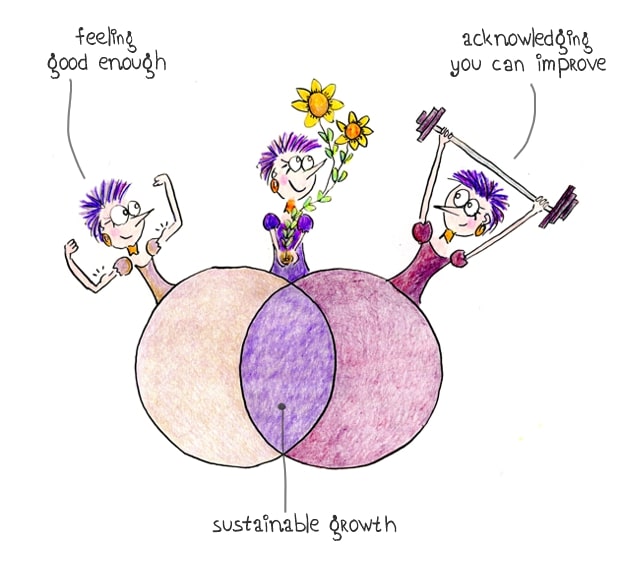
7. Practice X-ray reading
X-ray reading is like reverse-engineering.
When you reverse-engineer a bicycle, you disassemble it to understand how all parts fit together, and you try to put the bike together again.
In a similar way, you can take a piece of writing apart to understand how it works. It’s one of the most valuable skills to learn as a writer.
To practice your X-ray skills, focus on one aspect of writing at a time. For instance:
- If you find structure hard, study how others structure their writing.
- If you want to write better openings, study which opening paragraphs captivate you and make you want to read on.
- If you want to add pizzazz to your writing, observe how others choose words and use techniques like metaphors and strong imagery.
To become a better writer, become a better X-ray reader.
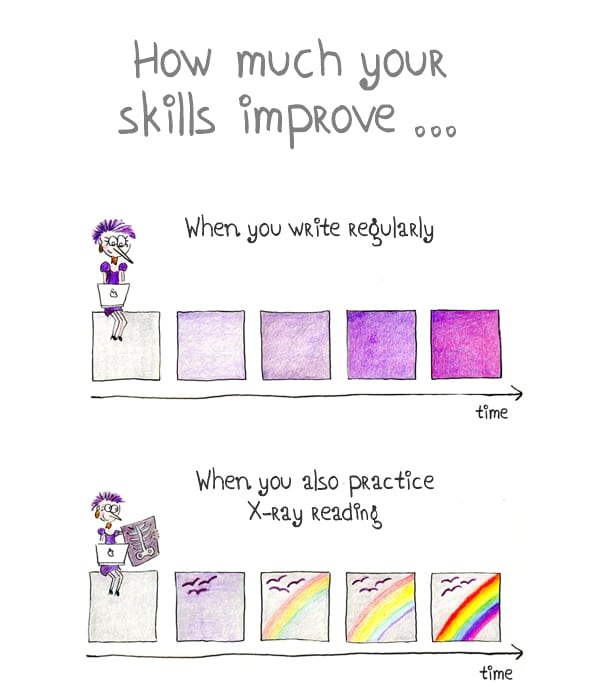
8. Put in the effort to write simply
A simple text is almost effortless to read.
And it can feel like the words have just flowed out of the writer onto the paper.
But that’s not how writing simply works.
The LOWER the effort to read, the HIGHER the effort of the writer.
Writing clearly and simply is hard work. But you know what’s so wonderful about it?
The writing process crystallizes your thinking. Your ideas become sharper, more luminous. And readers will love how you make them feel smarter.
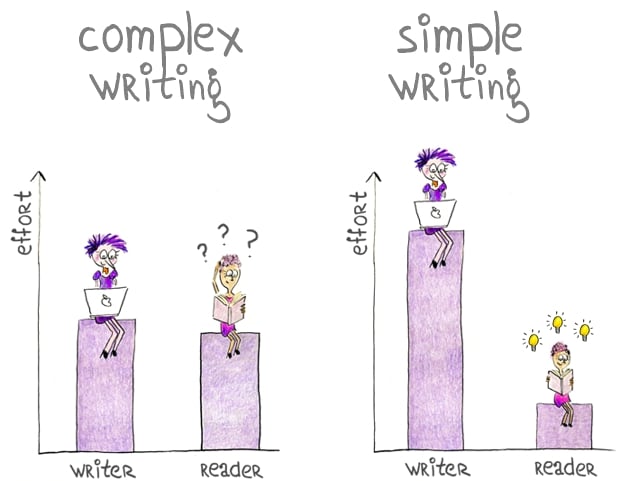
How to up your productivity
Want to write faster?
The weird thing is that trying to go faster might slow us down.
Sound crazy?
In his book Accidental Genius, Mark Levy describes how Robert Kriegel, a mental coach, trains Olympic athletes.
One time, during a practice run he found his sprinters were tense and tight. Rather than asking them to up their efforts, he requested they run the next practice round at 90%.
The result?
Everyone ran faster the second time!
So, here are some suggestions to take it easy and write faster …
9. Trust your process
To write with more ease, learn to embrace the messiness of the creative process.
Writing is often taught as a simple, linear process:
- Pick an idea
- Create an outline
- Write a first draft
- Revise and edit your draft
- Format and publish your final version
But writing is rarely that straightforward.
Writing shows up the flaws in your thinking. Ideas you had in mind turn out differently in a draft text. An outline might not quite work the way you thought.
Writing is uncertain.
But when you learn to embrace the messiness of the process, you can turn any crappy draft into decent writing.
So, sit with the discomfort and the doubts; and get to work … step by step.
Through the work, you’ll sharpen your thinking.
And your ideas will shine more brightly.
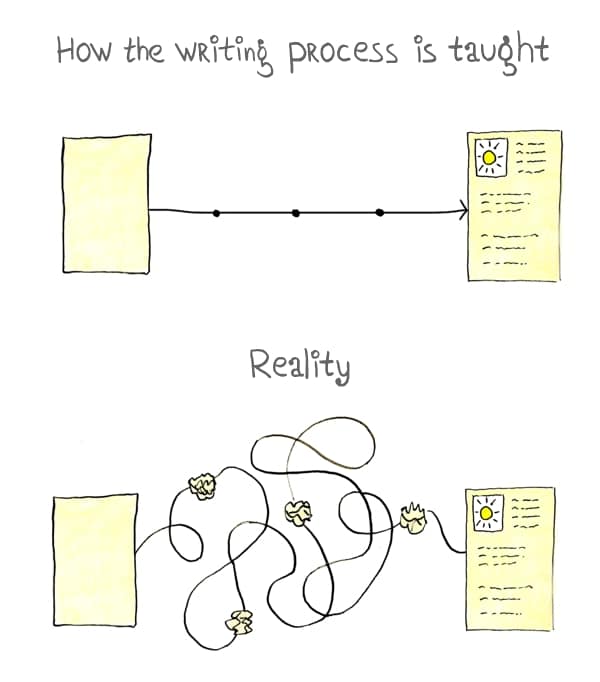
10. Harness the creative power of breaks
To be a productive creator, make time for both focused productivity and diffused-mode thinking.
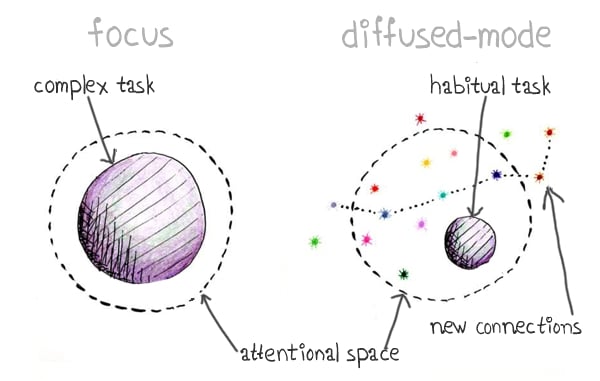
Focus is your productive super-power.
When you’re focused, one task occupies most of your attention. You can do deeper work, and do it faster.
You can train focus by choosing a task, eliminating distractions, and setting a timer. Whenever your mind wanders, refocus on the task.
But focus can also create a kind of tunnel vision.
So, to boost your productivity, plan breaks from focused sessions.
When you’re in diffused-mode, one habitual task—like walking, folding the laundry, or washing the dishes—takes up some attention, while your mind roams to make new connections.
That’s why I often get my best ideas when out on a walk. You might get your best ideas under the shower or in the gym.
It’s because our brains keep processing ideas even when we’re not focused.
So, breaks are a creative super-power.
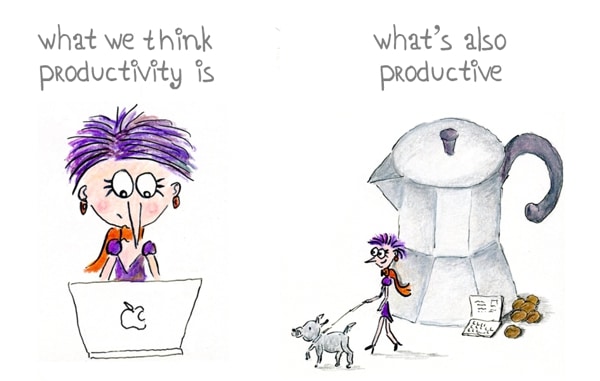
11. Make peace with your inner critic
I’ve heard people say you must simply banish that nagging voice.
Lock it away in a drawer. Or knock it out.
But that’s not easy, is it?
The harder I tried silencing my inner critic, the more agitated she became. I felt fed up. My inability to tame my inner critic made me feel weak and inept.
Until I had a mini-breakthrough.
It was in 2014.
I was diagnosed with a serious whiplash injury. At first, I tried to keep up with my normal life. But in December 2014, I broke down. My body didn’t want to co-operate anymore.
I was exhausted.
To heal from my injury, I learned to listen to my body. I learned to slow down and to treat my body like an ill baby I had to take care of. Gently.
The same was true for that voice in my mind.
I didn’t have the energy to fight her anymore. So, I learned to be kind to her. To accept that she was only telling me I was scared.
Over time, writing became less stressful. More joyful.
Now, I can’t tell you my inner critic and I have become best friends.
She still nags me.
But I know we can work together.
I know she’s warning me I’m doing something new, exciting, scary.
And I know that the best way to keep the peace is to take care of myself, to take tiny steps forward, and to never be ashamed of feeling scared.
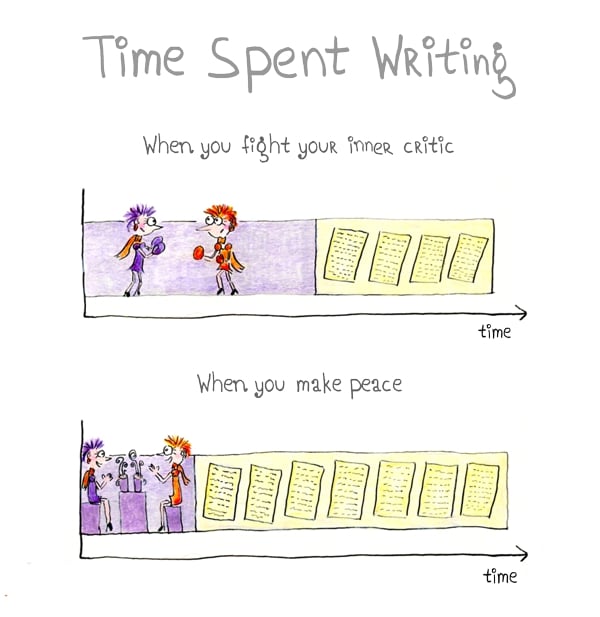
How to gain momentum
Got a big writing goal for this year?
Fab!
Set your goal, and then forget about it. Instead, focus on taking one step at a time.
Why?
Big goals invite procrastination, and small steps carry forward momentum.
Here’s how to keep momentum and get more writing done …
12. Set a doable target
We often underestimate how much we get done by doing a little work consistently.
Gustave Flaubert, for instance, wrote Madame Bovary by writing every evening, completing two pages per week.
And Stephen Guise wrote his book Mini-Habits by aiming to write 50 words a day.
Writing 50 words a day may sound like a stupidly low target …
But he could accomplish 50 words even when he was busy, felt tired, or had a thumping headache.
And he could keep momentum going.

13. Just start
In his book Meditations for Mortals, Oliver Burkeman suggests we’re trying to live life as if we’re the captain of a super-yacht. Calm and in control.
But in fact, we’re only in a kayak paddling in a fast-flowing river. We have much less control than we think.
The captain’s approach to starting (or growing) a writing habit is to try finding the perfect system: Read a couple of productivity books, sign up for productivity apps, buy a wall planner, and think how to best start that writing habit.
Of course, systems can be useful, but they can also form a distraction.
And really, if we want to write more, all we need to do is sit down and write—write because it matters to you.
Maybe that feels like an uncomfortable idea because it feels too simple or too uncertain but that’s kind of Burkeman’s point.
I find it an interesting way to think about writing.
So, what would you really want to write this year?
Let’s do it. Start tomorrow, or the day after, and then keep going … A paragraph or two on most days gets you further than you’d think.
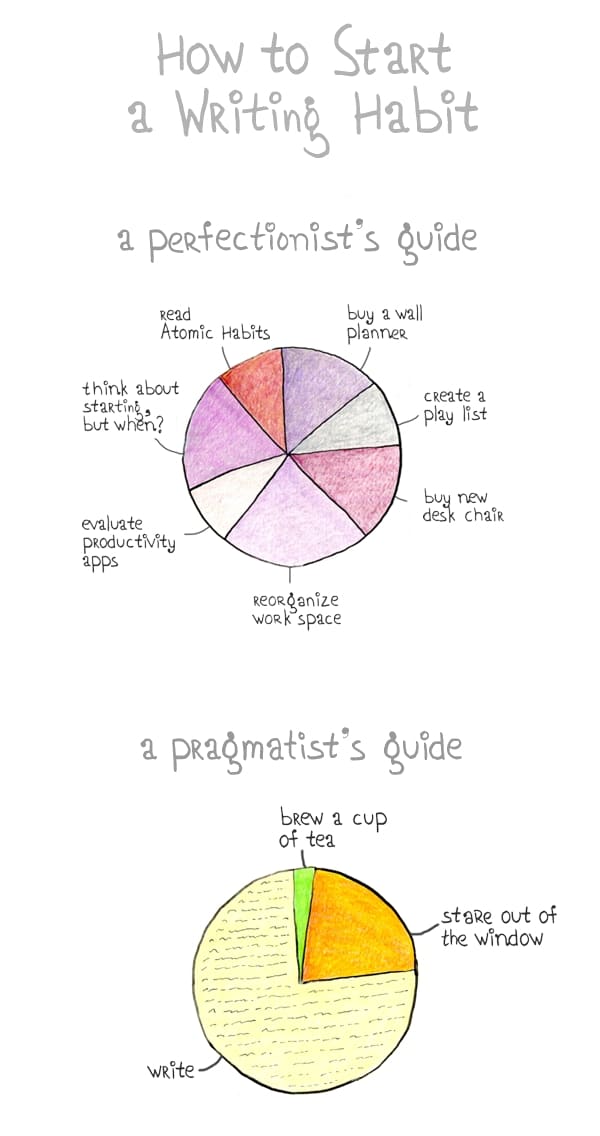
14. Make writing a choice
Want to make it easier to start writing?
Stop telling yourself you SHOULD write because SHOULDs breeds resistance.
The more I’ve moved away from SHOULDs, the more joyful writing has become, the keener I am to write, and the higher my productivity.
So, stop telling yourself you should write more; instead make writing a choice:
- I want to write
- I feel lucky I can write today
- I choose to start my day with writing
- Today, I get to write
Let’s lean into the joy of writing, the joy of creating something that didn’t exist before.
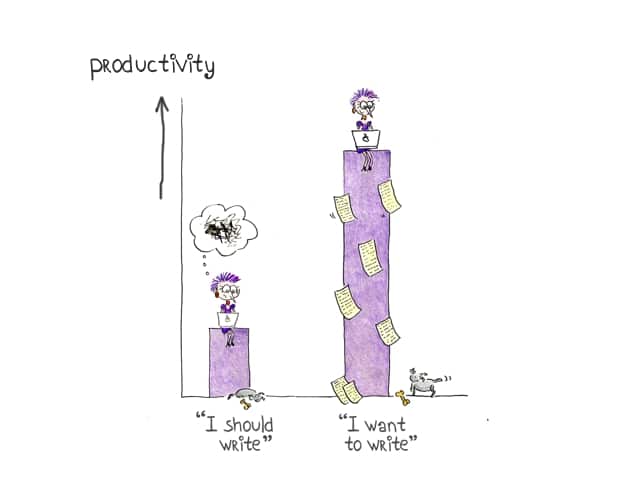
Kindle your inner fire
In the past year, NYT writer Frank Bruni has often been asked where we find joy when there’s so much pain in the world.
His answer: “In language.”
There’s beauty and ingenuity in other people’s writing. Not only can we learn from each other; we can also appreciate the feeling of connection, the human spark that’s lighting up someone’s words, the recognition of our common humanness.
And there’s beauty in writing ourselves. In finding the words to communicate our ideas with gusto, to connect with our fellow humans, to pay attention, to care about what we write, to recognize the power of our words, and to make our words sing.
Aren’t we lucky we get to write?
Happy writing, friends.
Take care, and remember: Human content wins.
Recommended reading on writing habits habits:
How to be a prolific writer: 6 myths
How reading feeds my writing habit
3 creative habits that’ll keep you inspired all year


My goodness do I love this post! I am doing a lovely but also challenging “Article a day challenge” with a community and have been reading something on copywriting everyday for the entire February. That’s how I found your blog and this post. I wish I had found it at the start of this year or earlier in my copywriting/content writing career even. I found many gems that might have made my journey smoother. Some I have developed myself and I enjoyed seeing you put them into words. My best is on making peace with your inner critic. Well done!
Thank you so much for your lovely comment, Rosemary. I’m glad you found me. Better late than never 🙂
Hi Henneke,
?
Does that ginormous Bialetti espresso pot in rule #10
“Harness the creative power of breaks”
also serve as a hot tub for Henrietta when she needs to unwind after a powerful writing session?
“Meditations for Mortals”-Oliver Burkeman, I just finished it and turned it back into the library. I was going to spin another lap through it but there were holds. I’m not that mean. Spread the knowledge wealth and all. Just might have to buy a copy at some point.
“One of the few ways I can almost be certain I’ll understand something is by sitting down and writing about it. Because by forcing yourself to write about it and putting it down in words , you can’t avoid having your say on the subject. You might be wrong, but you have to think about it very intensely to write about it.”-Hunter S. Thompson
One of the key points I remember from by sharing a drink with the late, great Doctor of Gonzo.
Oh, by the way. Greatest post EVER!
Masterclass in motivation and inspiration.
When does your expansion into a book come out?
I’m more than ready to throw down some cash for that.
I hope this message finds you well.
Phil LeMaster
I love the idea of Henrietta unwinding in the giant espresso pot as if it’s a hot tub. I can picture it now! 🙂
“Meditations for Mortals” is such a good book, isn’t it? I’m reading it slowly. Just a chapter a day. You might like Oliver Burkeman’s newsletter “The Imperfectionist,” too. Many of the chapters of “Meditations for Mortals” started out as newsletters.
I love the quote of Hunter S. Thompson, and it’s so true. Writing shows up the flaws in our thinking.
I appreciate your compliment on this blog post. I need to start seriously thinking about that book.
(The challenge I have is that there’s so much I’d still like to write.)
It’s always a pleasure when you’re stopping by, Phil. Thank you.
Your best post so far? What a delight to read, what a visual treat. Well done!
I found the content so useful given the current times: ChatGP, content creation madness and unrealistic expectations of our time to do it all. More content on this please.
Thank you so much, Virginia. That means a lot to me.
And I’m with you; it feels quite challenging at times to forge our own path and stick with human content. But I do believe that human content will win.
Orbit Media do a annual blogging survey, and they’ve found in their 2024 survey that bloggers who use AI do not report better performance: “For the most part, bloggers using AI are getting the same results as everyone else.”
Mark Schaefer even predicts that there’ll be a negative correlation between using AI and performance: “I predict that in the near future, there will be a correlation between the use of AI and blog success, meaning, the more AI, the less success. At least for now, the AI shortcut is creating an unmistakable pandemic of dull.”
Thank you Henneke (& Henrietta) for this fabulous post.
I suggest you make this into a book – it is brilliant, inspiring, down-to-earth and funny.
I am writing a book this year, with a co-author, about how to use art to bond with neurodivergent children. It will be my first book and I’m both excited and terrified.
I love the idea of 50 words a day …. that seems doable.
Thank you both so much,
Bridget
Such lovely feedback. Thank you, Bridget.
It was difficult to keep this blog post to a manageable length so I like your suggestion to turn it into a book. Each section could easily turn into a chapter and then there are few more chapters I could probably add.
I love the topic of your book. Making art can be so powerful. And having a co-author can help keep momentum going!
Warmly,
Henneke
Wonderful content and style.
Reading this has encouraged me to enjoy writing and be realistic about my progress. Especially liked the suggestion to write a little daily or read and note words, style and good opening paragraphs. Thank you!
That makes me happy, Marti. Thanks so much for letting me know. Happy writing!
Your words always help to make my words more relatable and fun. I quickly wrote two newsletter drafts after reading just two of your tips. Thanks, cute lady!!
That’s so wonderful. Thank you for letting me know, Jen. I appreciate it. Happy writing!
That was amazing! Thank you so much. It was just what I needed to hear.
What a lovely comment. Thank you, Anita.
Great post, Henneke. So much wisdom and the generosity to share it with us. Yes, as you say, connecting with the inherent joy of writing. That’s what it’s all about.
I’m glad you agree, Ralph. Thank you.
Superb writing here. I took a snippet of 3 pics..Loving the pic with the mokka pot.
Ahh, the mokka pot or percolator. I like that one, too. And now I am, of course, curious … which are the other 2 pictures you liked?
Hehe, my body felt like a bag of grinding rocks reviewing the image for the perfectionist’s guide, and light enough to fly when I moved down to take in the pragmatist’s guide image.
Right on, Henneke.
Your drawings are pure delight. And your writing is always a treat to read.
Being a pragmatist is the way to go. Thank you so much for your lovely comment, Gina. Happy writing!
Today’s message is gold, Henneke. Thank you! I’m in the process of rekindling my creative-writing spark, and it’s a slow process that’s only just started. Your post is encouraging and full of gentle signposts and directions. I’ll be reading this one again and again. Thanks, too, for the gift of Henrietta! If she can do it, maybe so can I.
I love that you use the word ‘gentle’ in your comment, Rachel. Because I think gentleness gets us much further than trying to bully ourselves. Gentleness and playfulness will win. Happy writing!
Where do we find joy in this world? In images! I loved the drawings/diagrams/doodles in this post. Thanks!
Thank you so much, Klaas. That’s a lovely compliment. I had a lot of fun creating these images!